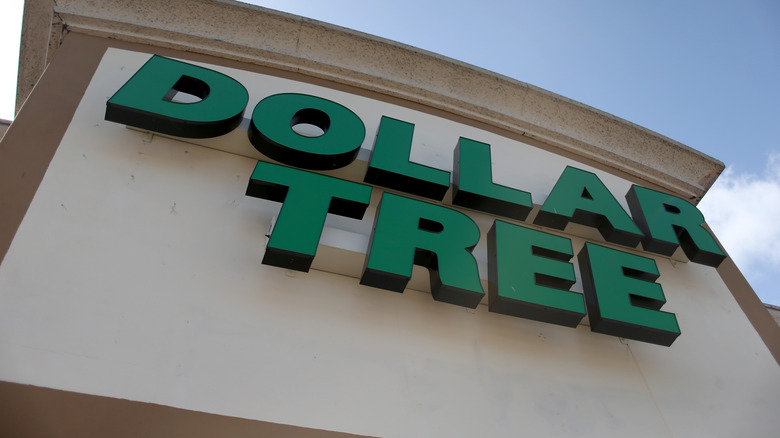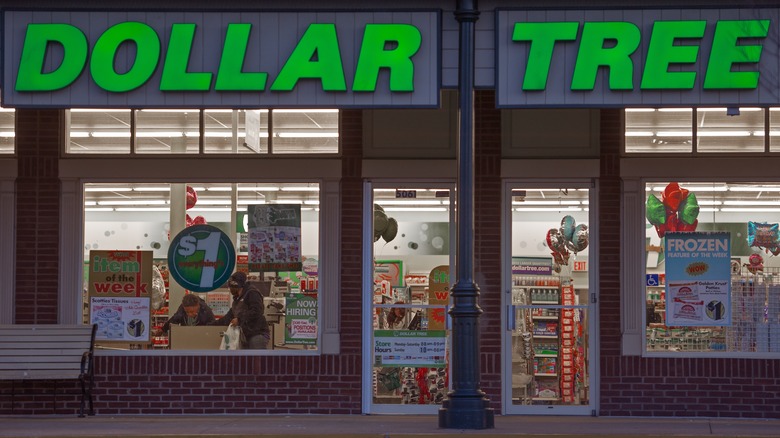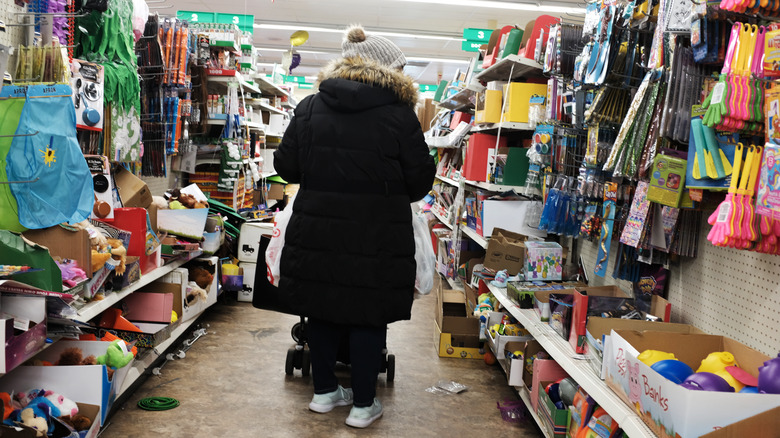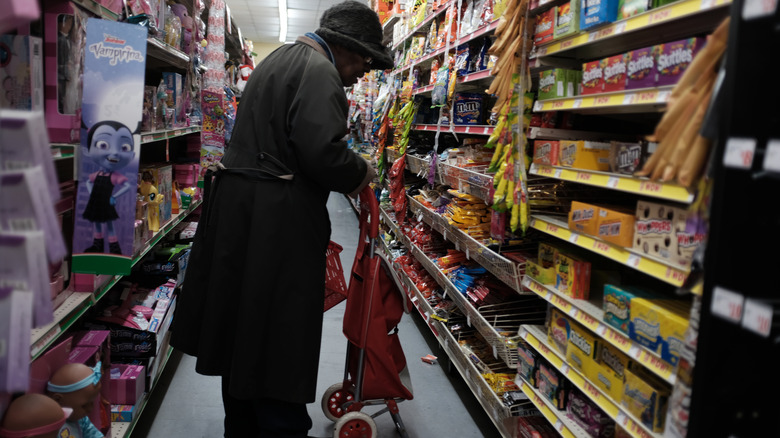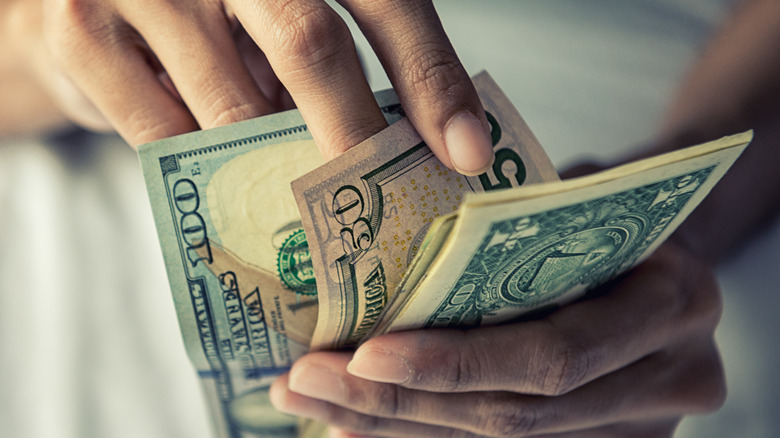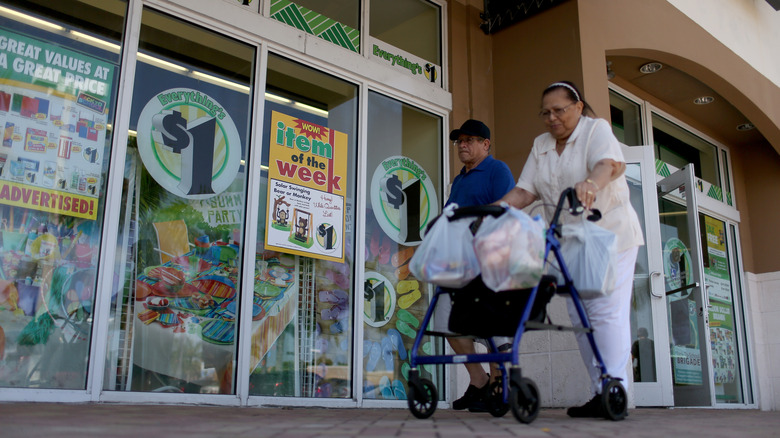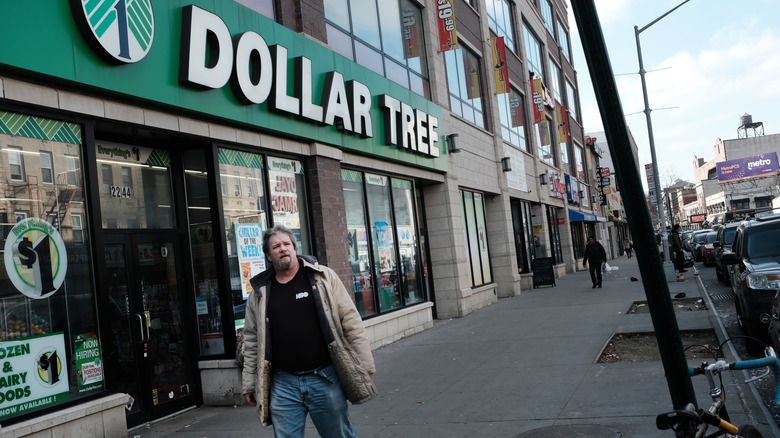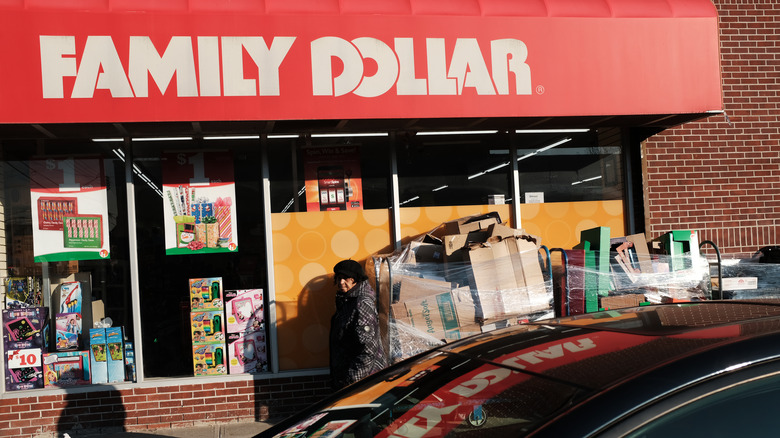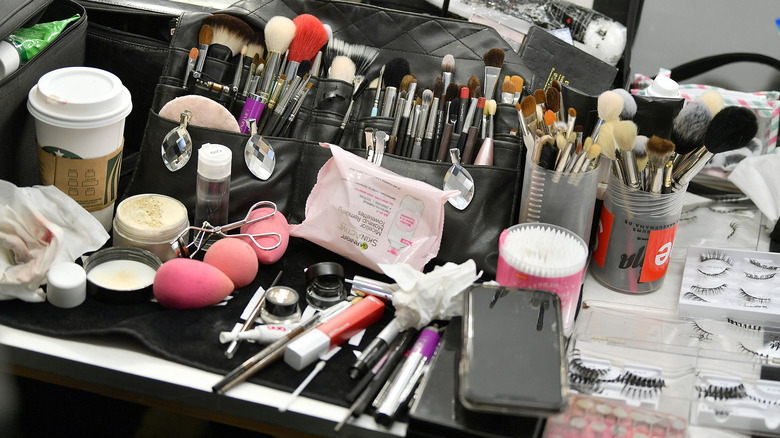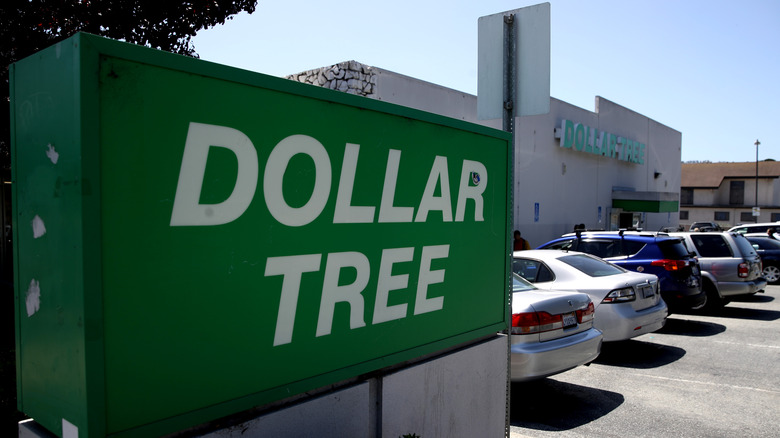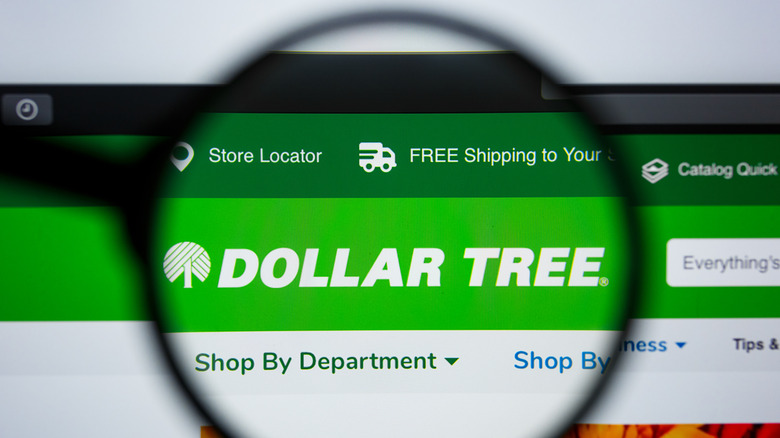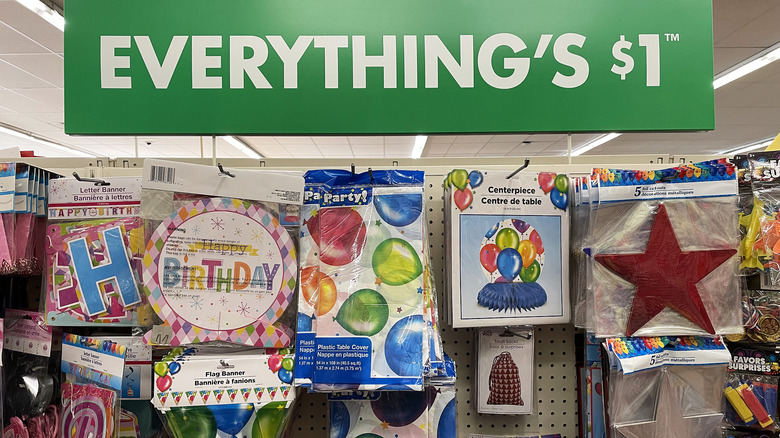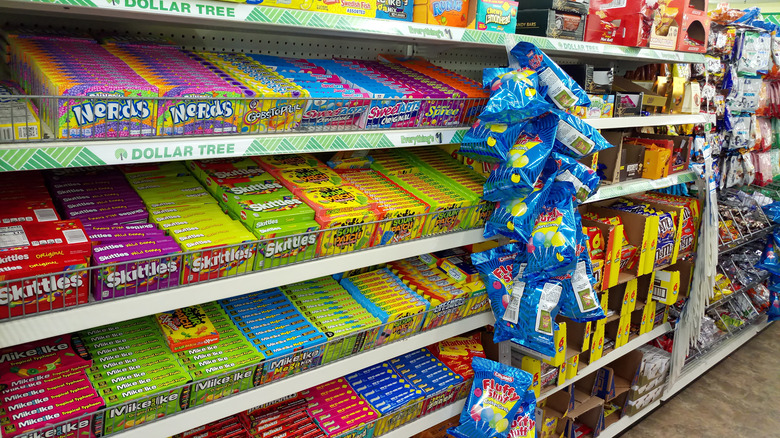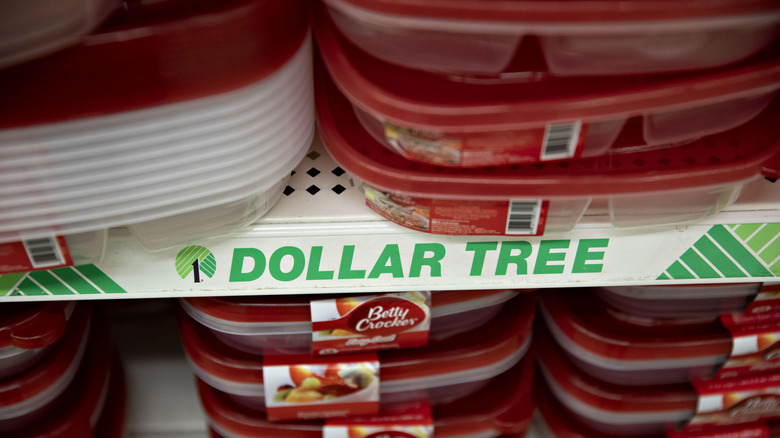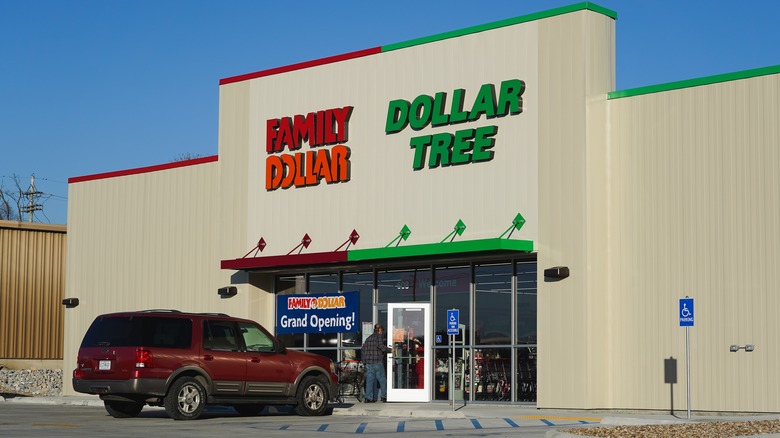The Untold Truth Of Dollar Tree
Dollar stores are everywhere. Descended from the popular five and dime variety stores of the 19th Century, they're sort of an American staple, even if they might be — for some shoppers with more discerning tastes — quite tacky. Adjusted for inflation, the five and dime became the dollar store. And it makes sense that they've become so widespread — where else can you buy skincare products and steaks at just a buck a piece? It's a no-brainer that they're super convenient. Of course, the quality of those products might not be all that great, but hey, you get what you pay for, right?
With its vibrant green logo and evocative brand name, Dollar Tree has grown to the top as one of the most successful dollar stores in the business. The industry powerhouse has been around since the early 1950s, and, along with other major names like Dollar General and 99 Cents Only Stores, Dollar Tree has become emblematic of American consumerism since its inception. As it's such a big name, it's worth looking into how Dollar Tree got to where it is today, how it makes its money, and how it's managed to keep prices down so low for so long. Seriously, how the heck is dollar store food that cheap?
It started out as a little mom and pop shop
Dollar Tree hasn't always been the variety store giant we know it as today. Back in 1953, per the company's website, a man named K.R. Perry opened up a franchise of a Ben Franklin variety store — Ben Franklin (which is still around in some small towns across America today, in case you were wondering) was a chain of discount arts and craft stores that took its name from Ben Franklin's aphorism, "A penny saved is a penny earned."
Later, K.R. Perry split his store off from the chain and renamed it K&K 5&10; he opened up another variety store called K&K Toys with his son Doug Perry in 1970. Through the '70s and '80s, K&K Toys began expanding out into malls across the American South. Doug Perry then went on to open his own stores with a model similar to that of the classic five and dime his father opened back in Norfolk — a store that sold everything for one dollar, fittingly titled "Only $1.00."
In the '90s KB Toys bought out K&K Toys from Perry and his business partners; they used the money to expand Only $1.00, which became Dollar Tree in 1993. In the years since, the company has acquired a number of other smaller dollar stores, thus expanding its infrastructure and allowing it to dominate the dollar store niche.
It started testing more expensive items in 2019
If you've ever set foot in a Dollar Tree (and let's be real here, who among us hasn't set foot in a Dollar Tree?), then this one should come as a no-brainer: some items are going to run up the bill quite a bit more than you expect them to, considering, well, you know, the store's somewhat misleading name suggests that everything there only costs a single buck.
The store began testing out selling more expensive items in 2019 as an initiative called "Dollar Tree Plus" — items costing more than a dollar were placed in small areas of the store to differentiate them from the rest of the discount items (via Retail Leader). The pricier options include items like three-pound bags of cat food, body wash, and brand-name cereals. Some items sold at the dollar store are just bizarre, though, no matter what price they have.
It sold $1 steaks in the freezer section
Of course, we all love a nice steak dinner. But then again, steak can be pretty pricey — for a steak that won't break the bank, you might be able to grab yourself a cheap hunk of meat at Dollar Tree — unlike the Dollar Tree Plus items mentioned above, these steaks are in fact, true to the dollar store's name, only costing a buck a piece.
According to ABC 13 in Houston in 2015, the steaks came frozen and pre-seasoned in a brine — they were sold by the brand Stampede, which you could find at other major retailers in larger portion sizes for a bit extra. Each package apparently came with two, 3.5-ounce steaks. That's not a bad deal if you're looking to stock up on a couple of cuts of beef and you're on a really tight budget, but larger packages might be a better choice if you want to get the most bang for your buck. For the record, ABC's taste testers said it was not nearly as bad as they had expected.
Some items aren't the bargain you think they are
If the concept of a dollar store has always sounded too good to be true to you, you're actually onto something — it turns out that while most items at Dollar Tree are indeed a dollar (or a, you may actually end up paying more per unit than you would at a more mainstream retail outlet, according to a post published on the website of consumer advocate Clark Howard.
As the post explains, since the vast majority of items at the store are all valued at the same price point — it's in the name, after all — things seem pretty cheap. But certain items, like spices and condiments, are simply not a great purchase, since you can find them in larger sizes for marginally more expensive prices (or in some cases, even cheaper prices) at grocery stores and other outlets.
For example, as Clark reports, you can get a 2.5-ounce bottle of garlic powder at the Dollar Tree for a buck, but you can also grab yourself a 5.5 ounce bottle of garlic powder for $1.19 at the supermarket chain Aldi. That's more than two times the garlic powder for far less than half the price. As a general rule of thumb, if you can find a brand name product for a dollar, it's probably a good deal — otherwise, you may just want to head on down to the nearest supermarket instead. And never buy milk at the dollar store.
It doesn't pay its employees very well
Since it's such a large and omnipresent entity in American society, it's clear that the higher-ups at Dollar Tree aren't facing too many financial hardships — in fact, CEO Gary Philbin has an estimated net worth of around $18.7 million (via Wallmine). Surely Philbin and the others on the company's team of corporate officers won't be feeling the need to shop at Dollar Tree anytime soon.
On the other hand, cashiers and managers at individual stores aren't so lucky. As with most other retail jobs, the pay at Dollar Tree is kind of low. The amount that store workers earn varies by state of course, but nationally, the average pay for cashiers at Dollar Tree is $11 an hour (this is $3-4 less than the average hourly pay for a cashier at Walmart), according to data from Glassdoor. As employees work their way up the ladder, they have the opportunity to make a bit more — on average, store managers earn a salary of $59,735 per year, again according to Glassdoor.
Numerous locations have gotten in trouble for hazardous conditions
Just take a quick walk through the aisles of your local Dollar Tree and it'll become clear pretty fast that the company doesn't exactly place all that much emphasis on cleanliness in its stores. In 2019, Business Insider ran a story detailing just how messy one Dollar Tree in Jersey City had become; what they found included randomly assorted products haphazardly strewn across a disorganized display table to fallen products laying out in the open on the floors.
But the Jersey City Dollar Tree wasn't alone in its messiness and disorganization — and perhaps it was let off easy too. In early March 2020, the Occupational Safety and Health Administration (OSHA) fined Dollar Tree for its overwhelming health and safety violations in locations all across the East Coast. OSHA inspectors have fined the company more than half a million dollars for violations at one Massachusetts location and about $300,000 for its violations at one in Pennsylvania.
The offenses were varied, and a number of them were even repeat offenses. In Pennsylvania, OSHA cited the store for having unsanitary bathroom conditions, boxes blocking exits, and uncompressed gas cylinders, among other issues with the store's maintenance. OSHA has cited other Dollar Tree locations in Florida and Missouri for similar violations.
These days, it's a Fortune 500 Company with more than 15,000 locations
Just a couple years after the company rebranded itself as the Dollar Tree, the store went public on the NASDAQ stock exchange in 1995. As the company bought out other popular dollar stores, Dollar Tree continued to expand and accumulate wealth. However, dollar stores remained a relatively specialized industry throughout the decade and into the early 2000s.
In 2008, things changed: the Great Recession had people constantly seeking out more cost-efficient options for their basic needs. While stores like Walmart and Target provided decent options, you can't get much more cost-efficient than pricing pretty much everything at around one dollar.
As The New York Times reported in 2009, the Great Recession was a boon for the Dollar Store industry, writing that, "while most big retail chains are closing stores and radically cutting back on new outlets, the dollar chains are planning to open hundreds of stores this year in some of the best locations to which they have ever had access."
As a result of the recession, dollar stores across the nation grew significantly, Dollar Tree included. In 2009, Dollar Tree entered the Fortune 500 at 499 for the first time in its entire history; it's remained on that list, steadily rising in rank to 137 as of 2022. And, according to Statista, it's got more than 15,000 locations.
It acquired Family Dollar in an $8.5 billion deal
Remember how we mentioned Dollar Tree managed to expand in large part because of its ability to acquire other dollar stores and nearly monopolize the variety store industry? One of the company's largest acquisitions was Family Dollar back in 2015. According to Inc., Dollar Tree and Dollar General both had a major bidding war over the struggling Family Dollar chain.
Although Dollar General bid higher than Dollar Tree, Family Dollar eventually sold to Dollar Tree because of antitrust concerns. While Dollar General did offer up more money for the chain, it's not like Dollar Tree's offer was particularly stingy — it spent a whopping $8.5 billion on Family Dollar. And as a result, Dollar Tree was able to increase its number of locations from around 5,000 in early 2015 to 13,000 after the deal was all done.
Although Family Dollar is owned by Dollar Tree, most Family Dollar locations have not been converted to Dollar Trees. Unlike Dollar Tree, Family Dollar has plenty of items that cost more than a dollar — yes, Dollar Tree also breaks its dollar store mandate on occasion as well, but a bit less so than Family Dollar. Family Dollar also focuses a bit more on selling brand-name items than Dollar Tree does, as Business Insider reported back in 2019.
It got in trouble for allegedly selling unsafe cosmetic products
In November 2019, the U.S. Food and Drug Administration had to send the company a warning letter for selling "potentially unsafe drugs," according to a report from CBS News. The letter revealed that Dollar Tree had been selling acne treatments that were developed in the Shanghai Weierya Daily Chemicals Factory, which the FDA had investigated before. The factory was found to use insufficient testing procedures on their products — for example, the company never actually tested to ensure that the products were free of any "objectionable microorganisms" (i.e., things like bacteria or viruses).
It gets worse though. One of the other companies supplying Dollar Tree with products, the China-based Bicooya Cosmetics, got in trouble with the FDA back in 2017 for not testing its products at all prior to selling them, as well as having rodent feces found throughout its facilities. A Dollar Tree spokesperson defended the store, telling CBS that all of the products the FDA had an issue with were topical, rather than ingestible, but added that it would be working with the FDA to ensure that the store's products met the agency's guidelines in the future.
It has been criticized for exploiting poorer Americans
Unsurprisingly, dollar stores tend to be located in regions with high populations of low-income and working-class individuals. Dollar stores have become extremely common in some of the most low-income cities in America, like Detroit and Cleveland, the latter of which reached a whopping total of 35 dollar stores within its city limits in 2019. Progressive organizations have accused that this business model — establishing markets in low-income regions and selling items at what's a seemingly low cost — preys upon poor Americans who don't necessarily have access to healthier food items, creating "food deserts" (via Insider).
Speaking with The Progressive, Charles Bromley, who's spearheaded the movement to limit the development of dollar stores in Cleveland, said, "Their whole strategy is to go to a neighborhood that has a lot of poor people who don't have access to transportation and can only walk to and from the dollar store."
As CNN reported in 2019, dollar stores — in particular Dollar Tree and its main competition Dollar General — have expanded quickly in recent years. But that expansion comes at a cost for the small mom-and-pop shops in the low-income neighborhoods where dollar stores tend to be most prevalent, while also limiting low-income Americans' access to high-quality products in their vicinity.
You can shop online
Cleaning out the candy aisle at your neighborhood Dollar Tree isn't strictly an in-person experience anymore. As a matter of fact, bargain hunters don't even have to put their shoes on for seeking the latest steals. There are thousands of items available on Dollar Tree's website, and it's on par with the selection you'd get in stores: home decor, kitchenware, and summer essentials like sidewalk chalk. One of the biggest perks of Dollar Tree's virtual presence is the Closeouts section. Here, customers can score wares that are heavily discounted as the store's way of clearing out surplus stock from the inventory.
As convenient as it can be, shopping online at Dollar Tree does come with a few downsides that make us question whether it's worth it. For example, shipping rates are determined by the volume of stuff being purchased, as the website shows, while free shipping is only offered on pick-up orders sent to the store. There's also the fact that most products are sold in bulk, not individually. So unless you want enough hair conditioner or paper plates to last you a lifetime, you'd be better off grabbing what you actually need in store.
We're not opposed to the idea of stocking up on the essentials — if the pandemic showed us anything, it's that preparedness is key. But a teddy bear for Valentine's Day or a cookie sheet probably doesn't warrant an online purchase if you only need one of them and not 12.
Most items now cost $1.25
As one of many dollar stores, Dollar Tree actually lived up to the name for a long time. Everything cost a dollar. But in January 2022, everything changed. CNN Business reported Dollar Tree's permanent decision to increase the price to $1.25, crushing 35 years of precedent that shook dedicated shoppers to the core. Around 2,000 locations at the time took on the new sum, and per a company statement, the shift would take place at all locations by the year's end.
Within the first week of taking effect, store sales reportedly plummeted 6.2%, and angry fans began referring to the chain as "$1.25 Tree" (ouch). Many reasons could explain why Dollar Tree, in the words of co-founder Macon Brock, "ditched the dollar" altogether. There are inflation and supply chain issues to contend with, as always, but the chain weathered similar conditions decades before. The truth of the matter, chief executive Michael Witynski told Market Watch, relates to improving the shopping experience.
The rationale is that raising the price, even by a quarter, will allow the chain to reintroduce items that have previously been discontinued due to cost, such as cult-favorite food items. As a result, Dollar Tree will have "greater flexibility" in running the business, perhaps even drawing more customers through its doors than believed to be possible. A dollar was dependable, sure, but a dollar can only go so far in keeping the lights on, even for a discount haven like Dollar Tree.
How exactly is everything so cheap at Dollar Tree?
Prices hikes aside, we'd be lying if we said Dollar Tree didn't offer some of the biggest bargains around. How is it so easy to spend a buck on, say, a liter of soda or body wash? We'll tell you — it has everything to do with a classic industry tactic: private labels. In 2019, Business Insider ran a story revealing that Dollar Tree, along with Five Below and Dollar General, sells items produced by third-party companies that are made exclusively for the retailer.
Typically, the packaging is quite generic or goes as far as copying the look of the original, but the item is significantly less expensive in comparison. You've likely encountered these brands without even realizing it. Trader Joe's and Aldi are companies well-known for using them, as examples. In the case of Dollar Tree, Business Insider noted specific brands in particular that can be identified on the shelves, and where they actually come from.
There's a brand of jarred spices called Supreme Tradition and a line of cosmetics and beauty tools called Sassy & Chic, both manufactured by the company Greenbrier International Inc., which Dollar Tree owns. Additionally, Dollar Store Reviewer discovered that the brand Homestyle Select and many children's toys share a home under the Greenbrier umbrella. The label won't always be obvious to the naked eye, but the deal you'll receive in return is nothing but crystal-clear.
You can lower costs even more by using coupons
As a discount store, Dollar Tree's prices are already exceptionally low. Yet it's possible to score even more deals when doing your weekly run, as long as you know where to look for them. Customers can use manufacturer coupons on eligible items, assuming they fall before the expiration date and that the amount of coupons doesn't exceed four per product (per Dollar Tree). Even with limitations, of course, this means that buy-one-get-one deals on Hershey's candy bars or Dove skincare will be accepted so long as the official coupon is right in your hand.
What's more, bargains can be doubled with the help of couponing apps like Checkout 51, Fetch Rewards, and Rakuten, which also provide cash back opportunities and other perks any time you make a purchase (via The US Sun). And because it's the 21st century, Dollar Tree also has an app of its own. It's available on Apple or Android devices and offers deals that aren't available outside its digital platform, which means you have to download it to take advantage. Between third-party vouchers and store-wide promotions, there's no need to ever pay full price if you can help it.
What items will get you the most bang for your buck? Take TikTok account The Freebie Lady's advice and stock up on toiletries like dish soap or paper towels — those tend to have ample coupons floating around with big savings guaranteed.
You should double-check the expiration date on food from Dollar Tree
Dollar stores usually offer the cheapest way of indulging our snack cravings, but there's a reason why that's the case. We've already seen Dollar Tree's cosmetics scandal, so it doesn't come as a shock that it's guilty of selling expired food, too. In one example, reporters from WFMY-TV happened upon a pickle jar at a location in Greensboro, North Carolina that was one month past its sell-by date.
Another horror story includes an Ohio woman whose daughter ate dollar store trail mix that had been left on the shelf six months after. And that's before getting to the poor soul who purchased a frozen pizza that had literally been chilling in the freezer for two years (via WCPO-TV). The worst part? It's technically legal in some states to sell food that's seen better days, including, as of 2019, the aforementioned North Carolina. Essentially, those cans of beans or lollipops could be collecting dust on the shelf for months before they even see the inside of a shopping cart and we'd be none the wiser.
Sure, packaged foods are stuffed with preservatives — it's what helps them stay fresh longer. But things do eventually go bad, and anything edible sold by Dollar Tree should be looked at with intense scrutiny. At the very least, you should look at the label very closely before bringing it to the checkout line.
You might want to avoid buying plastic food containers
In 2014, an explosive study by the progressive organization Campaign for Healthier Solutions discovered that 81% of products sold at dollar stores featured some sort of hazardous substance, per National Geographic. With that said, most of the plastic wares Dollar Tree sells fell into that camp, as the study, unfortunately, showed products including children's toys and school supplies contained traces of dangerous chemicals such as lead, bromine, and Polyvinyl Chloride (PVC).
You'll find water bottles and food storage containers are often made with Bisphenol-A, or BPA, a chemical that Healthline reports causes endocrinal issues ranging from reproductive capability to cell repair. Not only that, but it can shed off of surfaces and bleed into whatever you're eating or drinking, which makes it impossible to avoid.
Having established the disproportionate effect dollar stores have on marginalized communities, the CHS is pushing retailers to eliminate toxic substances out of inventory and the supply chain. So far, Dollar Tree's responded by joining the Chemical Footprint Project, which helps companies pivot to environmentally friendly and consumer-safe business practices. It's baby steps, yes, but it's still a start. Because developing chronic ailments, of all things, shouldn't have to be the cost for Americans buying silly straws for their kids.
Shoppers can double their savings with Dollar Tree/Family Dollar combo stores
We know that Dollar Tree's acquisition of Family Dollar has lead to a franchise-wide growth spurt over the last few years. Is it any wonder, then, that the two discount powerhouses would eventually join together under the same roof? Combo stores have sprouted up around the country, as Progressive Grocer reported in 2022, featuring both Dollar Tree and Family Dollar chains housed in the same building. These locations are apparently taking off in small, rural regions where traditional grocery stores might not be present, or shopping options are scarce (via Family Dollar).
Unsurprisingly, the hybrid approach has been enthusiastically received by fans of both dollar stores. "Customers love shopping the best of Family Dollar and Dollar Tree in one easy-to-shop local store in their community," CEO Michael Wytinski told Progressive Grocer. "The stores are driving a material comp sales lift, increased productivity, higher gross margins, and improved operating performance."
At the time of that piece's publication, there were only 240 combo stores on record, but a statement from Dollar Tree confirmed at least 400 additional locations are expected to open by the end of 2022. The end goal? At least 3,000 combo stores in the years to come. It turns out that the convenience of shopping at two big-box stores in one outing is a big deal for Americans bound by their cars to get what they need. We'd be shocked if most Dollar Tree chains after this weren't combo stores.
